![How to make and store Mango Pulp + Mango Pulp Recipe Ideas and Uses [+Video]](https://www.masalaherb.com/wp-content/uploads/2017/05/Mango-Pulp-gog-150x150.jpg)
I make Mango Pulp when I have too many mangoes ripening way too fast.
The fruit pulp of different Mangoes can be so useful even months after the harvesting season, plus the sweet mango pulp tastes great months later!
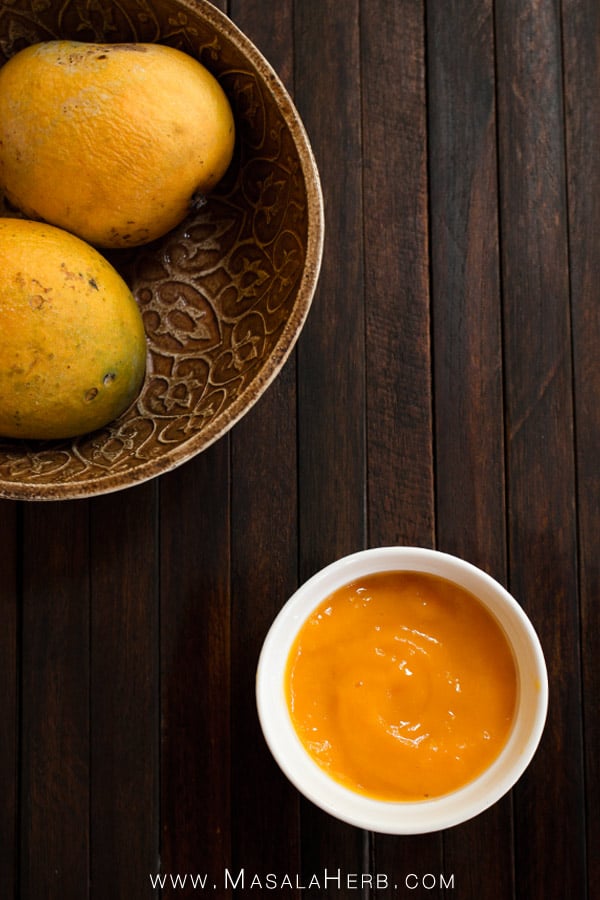
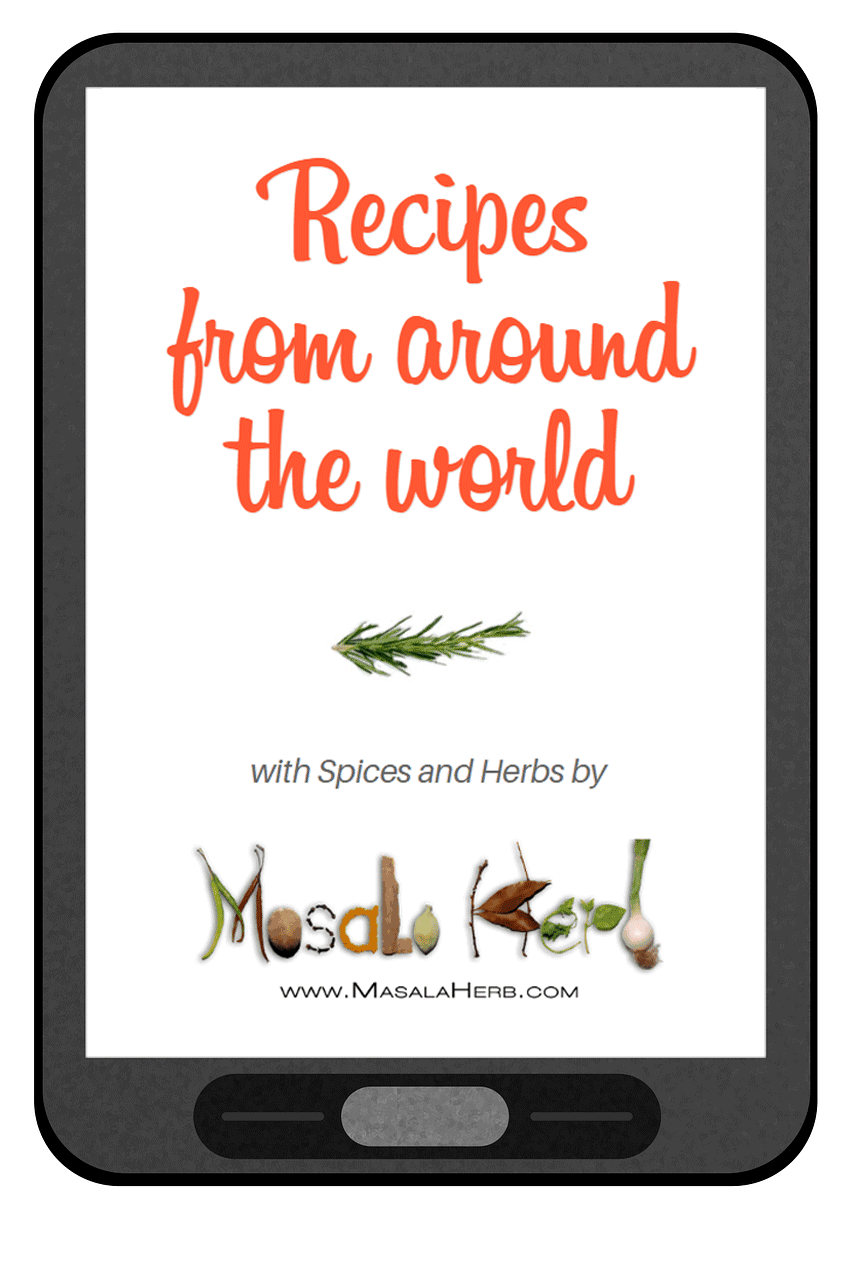
Global Food Recipes
with Spices and Herbs
Free E-Book available for a limited time. Grab yours now and get instantly inspired!
You missed out!
Jump to:
So if you would rather not make Mango Jam to use up your mangoes, then try out this mango pulp recipe.
🥭 Mango Qualities
This might surprise you, but making mango pulp is super easy and tastes of course way better then the store bought mango pulp.
Commercially available Mango pulp packed in cans and vacuum bags tends to taste less fresh and come with an un-pure mango flavor.
This might be because of added chemical preservatives.
The lowest mango quality grade is used in commercially available mangoes.
You don't really get the best mango pulp for your homemade precious desserts.
🌎 Where do Mangoes come from?
Nowadays, you can buy mangoes all over the world.
The mango fruit has come a long way in the past 20 years, it's as common as bananas in grocery stores in 2017.
In the US and Europe, you can get hold of Mangoes from Brazil all year round.
Mangoes from Hawaii, Florida or California are excellent as well!
The ripe mango season, in Asia, sweetens the steaming hot summer from April to June.
India and Thailand are known for their Mango love.
Countless Mango varieties exist in India alone making the Mango fruit India's national fruit.
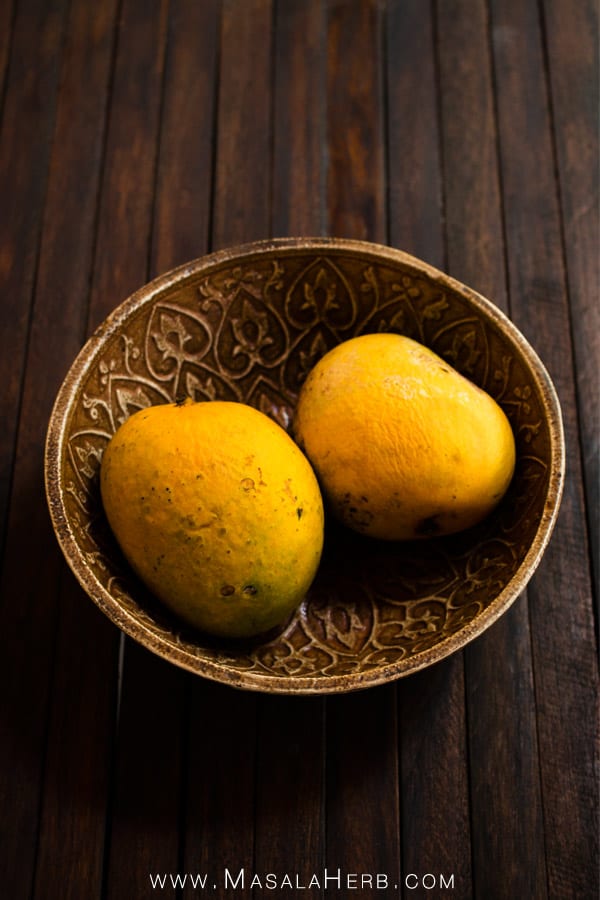
You can buy mangoes too during other times in the year, however, that is not suggested since the Mangoes won't taste that great.
However, getting "off-season" Mangoes is in many cases still better than buying preserved Mango pulp in a can.
📜 Mango varieties
When you live in India South East Asia, Brazil, Hawaii, and similar tropical environment, and you have a mango tree, you will end up with way too many mangoes to consume in time.
Usually, neighbors exchange a shopping bag full of mangoes among each other.
After all, not every tree bears the same mango variety and even if, the mango will still taste differently.
Mangoes are quite mysterious fruits. Having 2 bigger Mankurac Mango variety trees in our garden.
I can tell you that both trees produce different tasting mango fruits.
Yes, the base flavor is the same but the age of the tree, it's seed origin, the soil where it grows, general location, weather conditions of the previous months and the amount of watering determine the end resulting mango fruit flavor.
There are countless Mango varieties, with my favorite being the massive Bishops Mango.
The most common Mango type in the world in the Alphonso Mango and the most commonly available mango pulp in stores is of the same mango variety.
I don't particularly enjoy Alphonso mangoes, like others do.
It's a mainstream mango, so it suits most people to a certain amount.
The advantage of Alphonso Mangoes is that they don't have that many fibers.
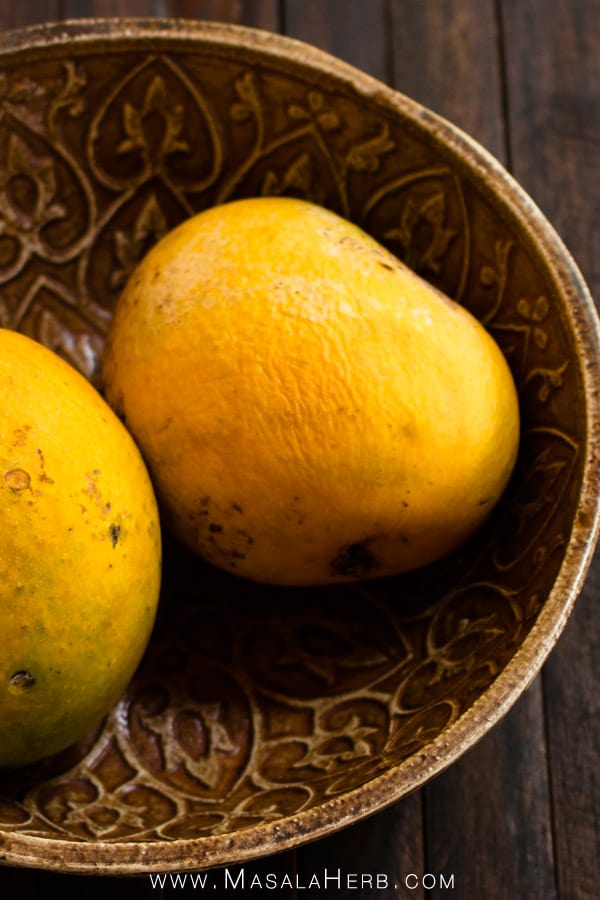
➕ Advantages of making your own Mango Pulp at home:
Use up ripe and soft mangoes before they go bad
Sometimes a batch of very ripe mangoes is sold at a very low price, that's when you use your smart and buy the mangoes and turn them into a pulp.
If you have a mango tree with a lot of fruits, finding ways to use the mangoes quickly and to store them, is a necessity.
Just pulp the mangoes and store for later!
Pick your favorite Mango variety to pulp
If you have more than one mango variety you can choose to pulp each separately or you can mix them up.
Some Mango varieties are better suited for Mango lassies too and others for cakes and this is something you could explore.
You get to choose your mango pulp flavor.
You know what's in your mango pulp
You make it so you know there are no added sugars or preservatives, plus you get to pick the quality of your mangoes used to ake the pulp.
It's easy and almost effortless and tastes way better then the store bought canned or vacuumed packets.
Homemade mango pulp won't disappoint you and won't turn bad if stored properly.
Freezing Mangoes as a whole with the core is not a good idea.
The mangoes turn ugly when defrosted, mushy and kind of not flavorful. That's why we make mango pulp.
🔪 How to prepare Mango pulp - How to store Mango pulp and How to cut Mangoes quickly
As you can see in the video, cutting off the ends first will save you time in peeling the mangoes.
That way you can cut the fruits without much mess, way faster and you need a quick method to cut a lot of fruits effectively without loosing the precious sweet mango juice.
Some Mango varieties have more fibers/strings in the flesh than others.
That's why Alphonso mangoes tend to be popular because they are almost without fibers.
Yet, there are 100+ more mango varieties in this world and half of those don't have fibers, so don't limit yourself to Alphonso only.
Use a mango variety with fewer fibers or you will need to strain the pulp since the fibers can be annoying.
Once you have cut off all the fruit flesh around the core and discarded the peel, you can cut the mango into chunks.
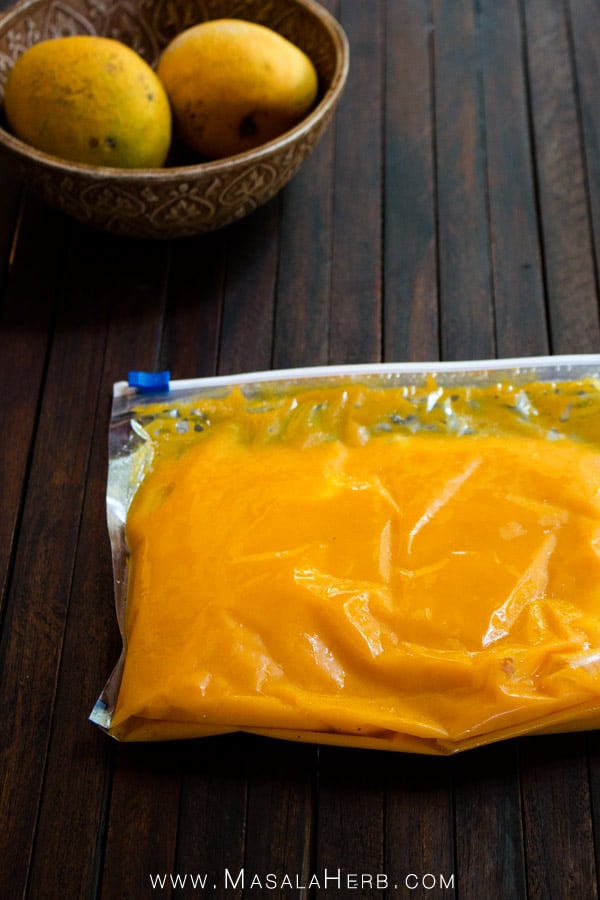
Then place them in a mixer/blender and just mix to a smooth paste.
Don't add water or sugar.
I wouldn't add any flavoring like cardamom or saffron at this point since you can always do that later.
Keep it natural and simple, so that you can use the pulp in various ways later in your food preparations.
I wouldn't add any flavoring like cardamom or saffron at this point since you can always do that later.
Keep it natural and simple, so that you can use the pulp in various ways later in your food preparations.
To store the mango pulp/puree, keep a few vacuum zip bags ready.
Fill the zip-lock bags with the pulp, close and place into the freezer.
You can use bigger or smaller bags, I prefer the smaller ones, batch-wise because it's easier to defrost when I want to use only smaller quantities.
Also vacuum zip-lock bags are easy to use, just open and use, and keep the mango pulp in perfect condition in the freezer.
It's more hygienic too and you will find that storing filled zip-lock bags will save you space in your freezer, compared to Tupperware boxes.
For one big bag, I used approximately 4 smaller mangoes the other day, so mango pulp is quite compact too in the freezer.
You have countless recipe options to use mango pulp in your food!
I searched the web and asked my friends to share their favorite ways to use mango pulp.
So besides the common uses such as Mango Juice, Mango Milkshake, and Mango Lassi, I was looking for more creative Mango pulp recipe ideas.
Some of the mango pulp recipes call for commercially available mango pulp, however, you can just use your homemade pulp instead.
💡 Mango Pulp Recipe Ideas
My personal favorites:
Non-alcoholic Beverages with Mango pulp 🍹
- Orange Mango Juice MasalaHerb.com
- Mango Lassi or Mango Shake
- Tropical Blood Orange Smoothie via GarlicandZest.com
- Mango Mastani via SpiceintheCity.co
Alcoholic Beverages with Mango pulp 🍸
- Mango Passion Fruit Daiquiri - via PassionFruitPawsandPeonies.com
- Spicy Mango Citrus Cocktail - via TastingPage.com
- Mango Mojito - via NutmegNanny.com
Dessert Recipes with Mango pulp 🍰
- Kiwi Mango Cherry Chia Seed Pudding - via StaceyHomemaker.com
- Coconut Panna Cotta with Mango Gelee - via LivingSweetMoments.com
- Mango Mousse Parfait - via VegetarianGastronomy.com
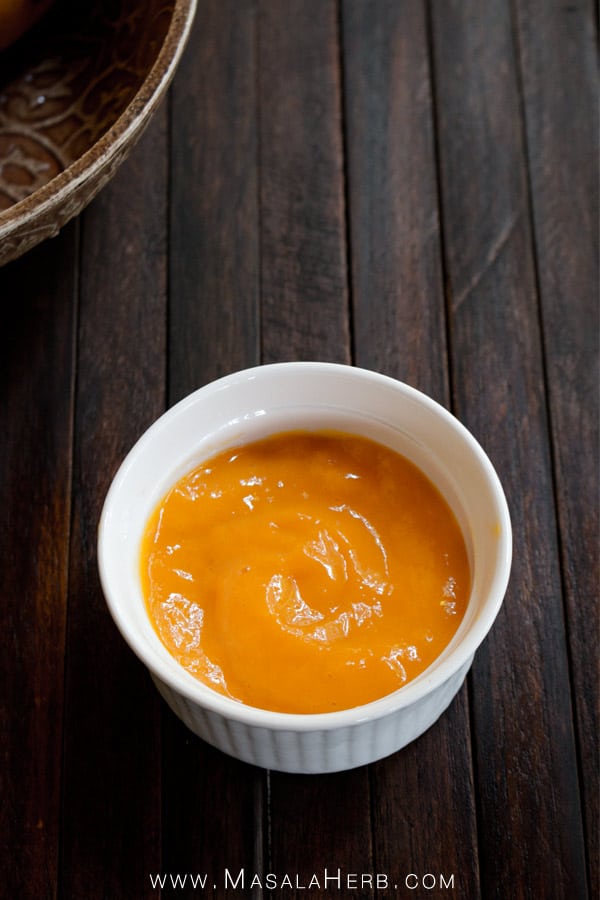
Ice Creams, Kulfis and Popsicles 🍦
- No-Churn Mango Ice Cream - via MonsoonSpice.com
- Mango Kulfi - Herbivore Cucina
- Mango Popsicle - Herbivore Cucina
Other great Recipe with Mango pulp 🍡
- Aam Papad - Mango Fruit Leather (Snack) - via MonsoonSpice.com
- Mango Frosting (for cake decoration) - via CakeWhiz.com
Dear Reader, How will you use your Mango Pulp?
![How to make and store Mango Pulp + Mango Pulp Recipe Ideas and Uses [+Video]](https://www.masalaherb.com/wp-content/uploads/2017/05/Mango-Pulp-pin-3.jpg)
📖 Recipe
![How to make and store Mango Pulp + Mango Pulp Recipe Ideas and Uses [+Video]](https://www.masalaherb.com/wp-content/uploads/2017/05/Mango-Pulp-gog-300x300.jpg)
How to make Mango Pulp
Ingredients
- Mangoes - Ripe orange or still green Mangoes.
Instructions
- Cut off all the fruit flesh around the core and discard the peel, you can cut the mango into chunks.
- Then place the mango flesh in a mixer/blender and just mix to a smooth paste. Don't add water or sugar and flavoring. Keep it natural and simple, to use it further in other dishes.
- To store the mango pulp/puree, keep a few vacuum zip bags ready or store in ice cube trays so that the pulp takes a square shape. Fill the zip-lock bags with the pulp, close and place into the freezer.
- Take out whenever needed and use further in your food preparation.
